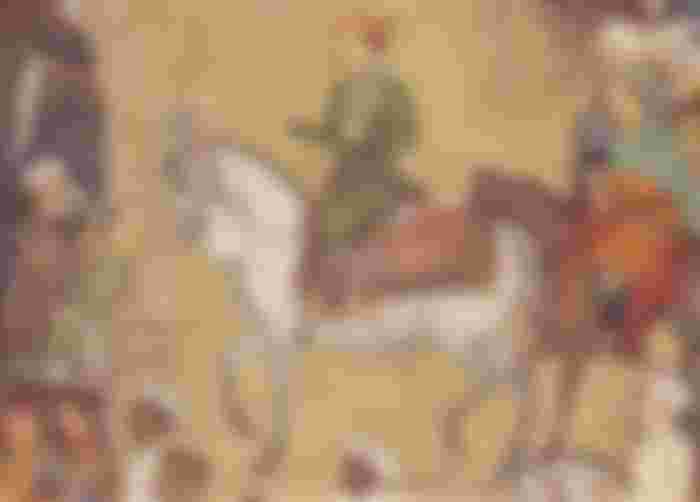There are few tales as tragic as this one, in the annals of the history of the Mughals. Once the favourite of his grandfather, Emperor Akbar, Shahzada Khusrau faced the wrath of a jealous father, an ambitious brother and lived with the knowledge that he may have caused his mother’s death. Finally, he was also done away with. Veteran bureaucrat and former Chairperson of the National Commission for Minorities, and former Chief Information Commissioner of India, Wajahat Habibullah, pens this piece on Khusrau’s tragic tale, helped ably by his grandson Rafay.
The tale of Mughal Prince Shahzada Khusrau (1587-1622) is not just a tragic tale of a promising young man who had a chance to make history; it is also a tale of how the course of history itself would have changed if he had had a more significant role to play in it. I believe that the die was cast for the ultimate decline of the Empire – which at its pinnacle was the richest the world had ever known until Europe’s Industrial Revolution – the day Khusrau was killed.
Shahzada Khusrau Mirza was the eldest son of Salim (later Emperor Jahangir) and was born on 16th August 1587, to Kachhwaha Princess Manbhawati Bai (born Rajkuwari Man Baisa Sahiba), also known as Man Bai. The daughter of Raja Bhagwant Das of Jaipur, she came from one of the most powerful Rajput families of her time. Man Bai was also the grandniece of Akbar’s own wife Harkabai (a Princess of Amer).
Prince Khusrau grew up in the Mughal household and was known to be a bright young boy. His grandfather Emperor Akbar (r. 1556 to 1605) was known to be quite fond of him. But as Akbar’s health began to deteriorate in the year of his death, a whirlpool of intrigue began to form in the Mughal court, which soon engulfed Khusrau as well.

In May 1605, Khusrau’s mother, Man Bai, died by consuming opium for reasons that remain unclear. Although she was Salim’s first and favourite wife, Jahangir would write of her in his autobiography Jahangirnama: “From time to time her mind wandered, and her father and brothers all agreed in telling me she was insane”. Khusrau was 18 at the time and reportedly a comely youth in looks and in temperament. The Englishman Edward Terry, a chaplain in the English Embassy to the Mughal court, wrote of him: “He had a pleasing presence and excellent carriage, was exceedingly beloved of the common people, their love and delight.”

Did Akbar seriously consider appointing Khusrau to the throne when he died instead of his son Salim, with whom his relationship in later years had been troubled? Salim had rebelled against his father. In fact, in 1602, Akbar’s friend and favourite Abul Fazl, author of the Ain-i-Akbari (a part of the Akbarnama that chronicles Akbar’s administration), had been beheaded at the hands of Salim’s friend Bir Singh Deo Bundela, his head gifted to the prince. Bundela would go on to become Raja of Orchha and one of Jahangir’s premier grandees.
We know that Khusrau had powerful allies on his side. The renowned Mughal general Raja Man Singh of Amer was his maternal uncle, while Mirza Aziz Koka, Emperor Akbar’s ‘foster brother’, was his father-in-law. The story goes that, as Emperor Akbar lay dying, Raja Man Singh and Koka summoned a meeting of the Umrah (nobility) to approve a new successor and attempted to seize the imperial treasury supposedly to ensure the succession of Khusrau.
The treasury was at the time under the charge of Ramdas, himself a Kachhwaha Rajput. In demanding the keys to the treasury, Raja Man Singh is said to have declared, “May I remind you who I am and what wonders I can accomplish?” Ramdas is said to have responded, “No Maharaja, I have not forgotten you…The same blood flows in our veins… If there can be any difference it is this, that one is guided by a feeling of devotion to duty.” It is conversations such as these that have become the stuff of legend. The Umrah supported Salim and a possibly frustrated Raja Man Singh left with his entourage for Bengal, where he was Subedar (Governor)

Upon Akbar’s death, Khusrau was confined to his quarters in the Agra Fort by order of his father, with only his first wife to keep him company. On 15th April 1606, Khusrau left Agra with 350 horsemen on the pretext of visiting Akbar’s tomb in Sikandra. On the way, he stopped at Mathura and was joined by Hussain Beg and his 3,000 horsemen. At Panipat, he was joined by Abdur Rahim, the administrator of Lahore. In Tarn Taran, a city founded by Guru Arjan Dev, fifth in the line of Sikh Gurus, Khusrau received the blessing of the Guru.
Khusrau then marched on Lahore, hoping to lay siege to it, but Jahangir met him with an even bigger army and routed Khusrau at the Battle of Bhairowal. Khusrau and his followers fled towards the Chenab but were captured. Khusrau was then taken to Delhi in chains, where he was paraded on an elephant while his supporters were impaled on stakes through their bowels, a method of torture that had been perfected by Ottoman executioners as a means of prolonging the agony. In 1607, Khusrau was blinded with a red-hot metal wire. He was 19.

Guru Arjan Dev was the first of the Sikh Gurus to attain martyrdom. Some believe this was due to his support for Khusrau’s rebellion. Although sources disagree on the manner in which he was killed, That martyrdom initiated a growing antagonism between the Sikh community and the Mughals.
Emperor Jahangir, though an opium addict, is believed to have survived to the age of 68 mainly because of the ministrations of his favourite wife, Begum Nur Jahan, who became the virtual ruler of the empire soon after their wedding in 1611. In her ascendancy, the Irani Nur Jahan also supplanted the Rajputs with whom the Iranis had hitherto vied to control the imperial harem.
In 1616, Khusrau, still being held in captivity, was handed over to Asaf Khan, the brother of Nur Jahan and father-in-law to Prince Khurram, third son of Jahangir by Jaipur’s Rathore Rajkumari Jagat Gosain. And from this has spun another tale of romance. The itinerant Italian composer, musicologist and author Pietro Della Valle tells us that Nur Jahan approached Khusrau in 1616-17, seeking his hand for her daughter Ladli Begum, from her first husband Sher Afkun, informing Khusrau of that which he knew: that Khurram had demanded the custody of Khusrau from Jahangir.

Khurram claimed that he feared another plot against Jahangir by his half-brother. Della Valle could hardly have been privy to the goings-on in the imperial harem, to which outsiders had no access and which, although powerful and often decisive organs of the State, remained always cloistered and secretive. But he tells of how Khusrau’s devoted wife urged him to accept the offer as a guarantee of survival, which Khusrau, out of devotion to her, refused. Why this should have been, considering that Khusrau already had two other wives, is anybody’s guess. But by 1620 Asaf Khan entrusted Khusrau to Prince Khurram who had by then been conferred the title Shah Jahan.
Shah Jahan ordered Khusrau’s death by strangulation in 1622, in Burhanpur, the Mughal capital of the Deccan of which Shah Jahan was Viceroy. He then informed his father that his brother had died of colic. In his Jahangirnama, the Emperor simply notes: “At this time a report came from Khurram that Khusrau, on the 8th of the month, had died of the disease of colic pains (qulanj), and gone to the mercy of God.”
In 1627, Prince Dawar Baksh, Khusrau’s son, was placed on the throne in Lahore by Asaf Khan, to keep the seat warm for Shah Jahan. Dawar, his brother Garshasp, uncle Shahryar, as well as Tahmuras and Hoshang, sons of Shah Jahan’s uncle Prince Daniyal, were all later put to death by Asaf Khan, who was ordered by Shah Jahan to send them "out of the world", which he faithfully did. Thus Shah Jahan set an unfortunate precedent for which he himself was to pay dearly when, in 1658, his sons rose against him and his heir apparent, Dara Shikoh, unseating him from the jewel-studded peacock throne that he had built through blood and tears. Strangulation was the means preferred since the days of the ancestor Genghis Khan, as Mongols recoiled from spilling the blood of royalty.


Under the orders of his father, Khusrau’s remains were buried in a tomb adjoining his mother’s in Khusro Bagh, thus further building on what was to become the very Mughal tradition of mausoleums for Begums in some of which their husbands also sometimes find a place – as with the Taj Mahal in Agra, Bibi ka Maqbara in Aurangabad and Burhanpur, the tomb of Mah Banu Begum, wife of Abdurrahim Khan Khanan, in Nizamuddin, and the tomb of Qudsia Begum, Empress of Mohammed Shah, in Alibagh (today’s Jorbagh) in New Delhi.
“Kingship recognises neither son nor son-in-law,” Jahangir had declared. “No one is a relation to a king.”





hello dear j will subscrib you please sub me back and help to grow each other